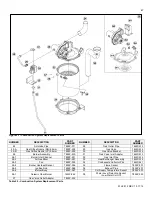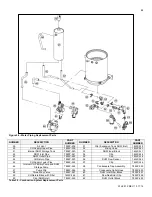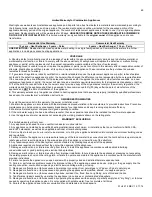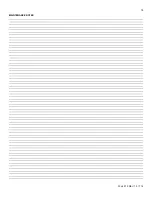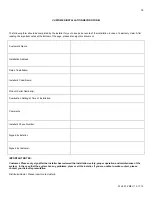
65
WHL-012 REV. 12.17.14
condensate hose from the heat exchanger. Remove the clear plastic hose from the hose barb. Remove the condensate hose clamp to
detach the condensate trap from the drain tube. Remove the condensate trap from the appliance.
3. Remove the bottom cap from the condensate trap.
4. Flush trap with fresh water to remove debris from the trap.
NOTE:
Ensure the float moves freely within the trap. If the float does not move, DO NOT reinstall the trap.
5. When the condensate trap is sufficiently clean, reinstall the bottom cap on the trap.
NOTE:
Ensure all parts shown in Figure 51, Condensate Detail, are installed with the condensate trap. If any parts are missing, DO
NOT reinstall the trap. Replace the entire assembly.
Do not install the condensate assembly if a component is lost or missing. Replace the entire assembly. Failure to follow this warning
could result in property damage, serious personal injury, or death.
6. Fill the condensate trap with fresh water prior to reassembly on the appliance.
7. Install the condensate trap on the condensate hose from the heat exchanger. Use the hose clamp to secure the trap. Attach the clear
plastic hose onto the hose barb. Reinstall the condensate hose clamp to detach the condensate trap from the drain tube.
Do not operate the appliance without the clear hose attached from the hose barb to the pressure switch. Failure to follow this warning
could result in property damage, serious personal injury, or death.
8. If a condensate neutralizer kit is installed with the appliance, check the assembly when cleaning the condensate trap, and replenish
the limestone chips if necessary. When replacing the limestone chips, take care to ensure chips are no smaller
than ½” to avoid
blockage in condensate piping (for piping details, refer to condensate neutralizer installation instruction.)
9. Check condensate piping for sagging and/or leakage. Repair any sags or leaks before restoring power to the appliance.
It
is very important that the condensate piping be no smaller than ¾”. To prevent sagging and maintain pitch, condensate piping should
be supported with pipe supports, and pitched ¼” per foot to allow for proper drainage.
The condensate line must remain unobstructed, allowing free flow of condensate. If condensate freezes in the line, or if line is
obstructed in any other manner, condensate can exit from the tee, resulting in potential water damage to property.
10. If the appliance has a condensate pump, ensure the pump operates properly before considering maintenance complete.
Содержание WBRCLP140F
Страница 2: ...2 WHL 012 REV 12 17 14 ...
Страница 38: ...38 WHL 012 REV 12 17 14 Figure 26 Electrical Wiring Diagram ...
Страница 39: ...39 WHL 012 REV 12 17 14 Figure 27 Ladder Diagram ...
Страница 73: ...73 WHL 012 REV 12 17 14 ...
Страница 74: ...74 WHL 012 REV 12 17 14 ...
Страница 75: ...75 WHL 012 REV 12 17 14 MAINTENANCE NOTES ...

















